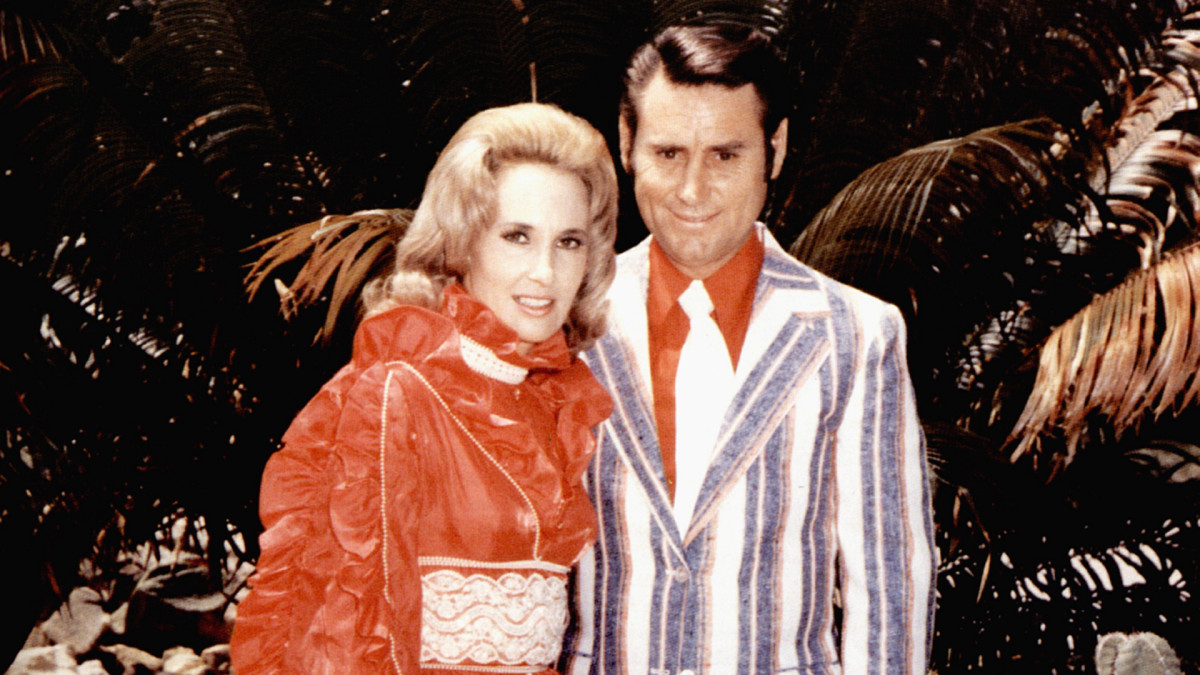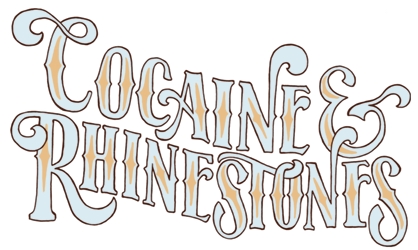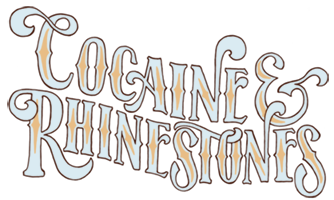
Though they were married to each other for little more than five years, the legacies of George Jones and Tammy Wynette are forever inseparable. This is partly due to their unprecedented success with creating music “based on the true story” of a romance between two artists, to such a degree that decades later there are still millions of fans who believe George and Tammy never stopped being in love with each other. If it’s difficult to say where the line is between art and artist, public and private, fiction and fact, then it’s only because there was a coordinated effort from perhaps a dozen people working to bury that line beneath a mountain of hit records and royalty checks.
Contents (Click/Tap to Scroll)
- Primary Sources – books, documentaries, etc.
- Transcript of Episode – for the readers
- Liner Notes – list of featured music, online sources, further commentary
Primary Sources
My main sources for this episode can all be found in The Main Library and the Season 2 Library.
Transcript of Episode
As part of my agreement with Simon & Schuster to publish a book adaptation of Season 2, the transcripts that have been freely available for over a year will be temporarily removed from this website. Please consider ordering a copy of Cocaine & Rhinestones: A History of George Jones and Tammy Wynette through your favorite local bookstore or requesting that your local library order a copy you can check out.
Liner Notes
Excerpted Music
This episode featured excerpts from the following songs, in this order [with links to purchase or stream where available]:
- George Jones – “Take Me” [Amazon / Apple Music]
- Tammy Wynette & George Jones – “Take Me” [Amazon / Apple Music]
- Tammy Wynette & George Jones – “Livin’ on Easy Street” [Amazon / Apple Music]
- George Jones & Melba Montgomery – “Living on Easy Street” [Amazon / Apple Music]
- Tammy Wynette & George Jones – “You’re Everything” [Amazon / Apple Music]
- Tammy Wynette – “Good” [Amazon / Apple Music]
- Tammy Wynette – “Take Me to Your World” [Amazon / Apple Music]
- Tammy Wynette & George Jones – “After Closing Time” [Amazon / Apple Music]
- George Jones – “We Can Make It” [Amazon / Apple Music]
- George Jones – “Small Time Laboring Man” [Amazon / Apple Music]
- George Jones – “Where Grass Won’t Grow” [Amazon / Apple Music]
- George Jones – “Right Won’t Touch a Hand” [Amazon / Apple Music]
- George Jones – “Loving You Could Never Be Better” [Amazon / Apple Music]
- Tammy Wynette – “Loving You Could Never Be Better” [Amazon / Apple Music]
- George Jones – “The Man Worth Loving You” [Amazon / Apple Music]
- Tammy Wynette – “We Sure Can Love Each Other” [Amazon / Apple Music]
- Tammy Wynette – “Fun” [Amazon / Apple Music]
- George Jones & Tammy Wynette – “A Lovely Place to Cry” [Amazon / Apple Music]
- George Jones & Tammy Wynette – “The Ceremony” [Amazon / Apple Music]
- George Jones & Tammy Wynette – “Old Fashioned Singing” [Amazon / Apple Music]
- George Jones & Tammy Wynette – “Let’s Build a World Together” [Amazon / Apple Music]
- George Jones & Tammy Wynette – “We’re Gonna Hold On” [Amazon / Apple Music]
- George Jones & Tammy Wynette – “(We’re Not) The Jet Set” [Amazon / Apple Music]
- George Jones – “Our Private Life” [Amazon / Apple Music]
- George Jones – “The Door” [Amazon / Apple Music]
- Melba Montgomery – “No Charge” [Amazon / Apple Music]
- Tammy Wynette – “No Charge” [Amazon / Apple Music]
- Tammy Wynette – “Woman to Woman” [Amazon / Apple Music]
- George Jones & Tammy Wynette – “We Loved It Away” [Amazon / Apple Music]
Commentary and Remaining Sources
Alright, these Liner Notes shouldn’t take very long.
The intro of this episode is about as close as we’re ever gonna get to a straightforward explanation of what’s happening in the intros of this season. Like you already heard me say, there’s a difference between handing someone a $20 bill and handing them a treasure map. One of those things is way more interesting to me than the other.
This is obviously not my only source on the Medici family or all of the interconnected religious, political and class conflict throughout Europe in the late medieval/early modern era but I did want to mention a couple articles because of how much I liked them and because I think most people who enjoyed my take on this stuff would enjoy reading these pieces. Those would be a pair of articles in Anne Thériault’s Queens of Infamy series on longreads.com. One is called The Rise of Catherine de Medici and the other is called The Reign of Catherine de Medici. Anne’s writing voice is more, I guess you could say, “modern” than mine, which I found helpful when trying to understand such a complicated story. There are hours worth of additional events I summarized or glossed over in providing only what I thought served the larger narrative of this season, so if you were interested in the parts of the story I told then you should know there’s way more and this is one of the best tellings I found.
One detail of the Medici/Valois story I found particularly amusing is: the monk who assassinated Henri III was named Jacques Clément. I have no idea if he was any relation to Cowboy Jack Clement but I would be surprised to learn he wasn’t aware of this small piece of historical trivia, as it seems like something he’d have gotten a kick out of.
When it comes to Catherine “inventing” ballet, there’s some stuff I’ll be talking about later in the season that makes me feel I should point out the difference between ballet and opera, which came along later. The quickest way to understand the distinction is that opera can include elements of ballet but ballet does not typically feature operatic singing.
This episode was originally released with a mistake that I’m sure not a lot of people noticed or care about but I’ve gone back to fix it. The details of the death of King Francois’ son, Francois, were originally attributed to the death of King Francois. It’s something I’m fairly certain was correct in the first draft of the season but all of the intros from the first one on bullfighting through to this one were originally written as one piece and then sectioned out into standalone segments across this run of episodes – you’ll notice Henri ascending to the throne happens right at the start of this episode – so at some point in the process of editing this intro’s beginning without having the context of the previous intro’s ending right there every time, it must have been worded ambiguously enough that I thought I’d made a mistake by referring to the not-actually-poisoned Francois as an heir while discussing his death right after discussing his father King Francois’ death. Anyway, after finishing Season 2 I bought some writing software that I’d been planning on migrating to and part of its purpose is to help prevent things like this from happening. Hopefully, it will.
I also want to point out that when I said many descriptions of either Tammy Wynette or George Jones could apply just as well to the other, I wasn’t saying any of those descriptions were somehow comprehensively accurate or that any description of one aspect of one person’s life could equally apply to the entire life of the other person. For example, the quotes you’ll see about Tammy needing things to be happening even if they were chaotic does not match the description given later in this episode of George being happy with a beer in front of the television, which is an accurate description of what George was like when he was trying to be a good husband to Tammy Wynette in this period of his life. If you replace “beer” with “industrial grade painkillers,” it’s also an accurate description of the “get high and watch hours of TV” routine Tammy settled into later in her life. On the other hand, the “chaos is preferable to nothing” attitude does accurately describe George Jones when he was failing to be a good husband in this period and, later, when he becomes addicted to cocaine. I will keep saying it because there will always be people who can’t see the forest for the trees but Season 2 is one story and we have only just entered the second half. I would recommend not focusing too much on the individual pieces until you’ve at least seen what the whole puzzle looks like.
My main sources for Season 2 are all on the Season 2 Library page.
Today I’ll talk a little about The Legend of George Jones by Charlene and Peanutt Montgomery. Look, neither of these people are authors and this book is poorly written. I cannot recommend reading it for pleasure and the whole thing feels like it only exists as some sort of self-defense argument from George Jones’ estranged friends trying to prove they were not the bad guys. As an example of the type of weird and petty complaints throughout the book, at one point Charlene (who wrote most of the book) takes issue with everyone referring to the period when George Jones was broke and mostly living out of a car as him being “homeless” because George always knew he could come stay with the Montgomerys. This kind of disjointed and rambling logic is always exhausting to sift through to figure out what kind of point the person is even trying to make. But, like I said in the episode, Peanutt and Charlene were two of the people closest to what went on behind the scenes of this marriage so their version of events has to be considered. The Montgomerys’ version of events does confirm information given by other sources and vice versa, so it was helpful in that regard, especially toward the end of trying to form a complete understanding of Tammy Wynette. And that reminds me of something I want to make sure to mention at some point in the Liner Notes of this season, which is how important researching George Jones was to understanding Tammy Wynette and how important researching Tammy Wynette was to understanding George Jones. Anyone who thinks they have a full picture of one of these people because they’ve read only books by or about that person is simply mistaken. This is yet another reason why the website has a Season 2 library page with info on sources for the season as a whole. It’s all too closely linked to present it any other way.
Alright, come back in a couple weeks for another episode on Tammy Wynette, covering the five or so years following her marriage to George Jones.

